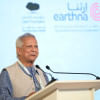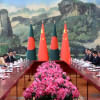‘We’re working very hard to increase Bangladesh’s export to China’

Chinese Ambassador to Bangladesh Li Jiming shares his views on the depth and prospects of the bilateral relationship between Bangladesh and China in an exclusive interview with Porimol Palma of The Daily Star, on the occasion of China's 73rd founding anniversary on today.
What are the achievements from the Chinese State Councillor and Foreign Minister Wang Yi's recent visit to Bangladesh?
China and Bangladesh are amicable neighbours and strategic partners of cooperation. Through the visit, China and Bangladesh renewed commitment to their traditional friendship, reiterated the One China principle, agreed to deepen strategic integration, and further enhanced practical cooperation, thereby jointly committing to maintain stability in the region and beyond amid an uneasy international environment.
Bangladesh is going through economic challenges in the wake of the Covid-19 pandemic and the Russia-Ukraine war. How can China help Bangladesh in mitigating this immediate challenge?
To meet the present challenges, I think Bangladesh can do the following together with China: first, join the Global Development Initiative (GDI) proposed by China; second, fully utilise and benefit from the zero-tariff treatment to 98 percent of Bangladeshi products exported to China; third, advance studies on Bangladesh-China FTA and enhance common development of Bangladesh-China economy; fourth, accelerate the promotion of the MoU on special assistance plan for disaster prevention and mitigation; and fifth, promote the work related to taka-renminbi currency swap and enhance Bangladesh's foreign exchange payment capacity.
China has two new initiatives: Global Development Initiative (GDI) and Global Security Initiative (GSI). What implications do they have for Bangladesh?
President Xi Jinping has put forward these initiatives in response to the urgent needs of developing countries as well as global development and world peace, following the guideline of policy coordination and practical cooperation, so as to help the developing countries maintain national stability, promote economic recovery, and advance the 2030 Agenda. I think these areas are also core concerns for Bangladesh; these solutions will surely assist Bangladesh in solving the present challenges and development difficulties if they can be effectively implemented. China is ready to work with Bangladesh to advance the implementation of GDI and GSI, step up coordination in international and regional affairs, safeguard the common interests of our two countries and other developing countries, jointly promote regional development and prosperity, and build a community with a shared future.
China is willing to strengthen the alignment of the Belt and Road Initiative (BRI) with Bangladesh's Vision 2041. How will it be done?
Bangladesh's Vision 2041 plan provides a roadmap for accelerating growth and lays down broad approaches for eradication of poverty, inequality and human deprivation. By implementing the plan, Bangladesh is expected to make rapid changes in agriculture, trade and industry, education, healthcare, transportation and communication, etc.
The BRI is the right avenue for tangible and intangible outcomes pertinent to innovative, harmonised, green, open, high-quality and shared development, which protects and maintains peace and promotes people's well-being in the post-Covid-19 era. BRI is proposed by China, but not owned exclusively by China. Ever since its genesis, BRI has been aimed at integration into the development strategies of all parties interested. Bangladesh is one of the first countries to respond to the BRI and has become one of the countries with the most cooperation and fruitful results under the BRI framework.
As strategic partners of cooperation, it is natural for Bangladesh and China to coordinate in terms of development strategies. We have established the Joint Economic and Trade Committee as an institutional arrangement for Bangladesh-China economic and trade cooperation. According to data from China, the bilateral trade between the countries increased significantly in 2021, exceeding USD 25 billion. The turnover of China's contracted projects to Bangladesh remained at the forefront of South Asian countries, and China's investment in Bangladesh increased by more than 290 percent year-on-year.
To further enhance integration of development strategy, the two sides could work together in several areas. First, we need to further strengthen political mutual trust, consolidate the foundation for win-win results, enhance risk management and control, and secure the cooperation environment against a rapidly changing international situation. Second, we need to further enhance intergovernmental cooperation and promote implementation of major projects. Third, we need to fully utilise the high-quality projects and expand the volume of cooperation, such as Bangabandhu Bangladesh-China Friendship Exhibition Center, the zero-tariff treatment for 98 percent of Bangladeshi products exported to China, and the large-scale international exhibitions like the China International Import Exposition and the Canton Fair. Fourth, we need to explore new opportunities and cultivate new growth points. Specifically, we can promote PPP cooperation, advance studies on bilateral FTA, jointly respond to the pandemic and climate change, restore rivers, develop green and low-carbon energies, and work together on a digital economy.
Bangladesh's export to China is less than USD 1 billion a year, though the bilateral trade is USD 25 billion. Why is the trade gap so wide?
About one-third of Bangladesh's imports from China are textile fabrics, cotton yarn and thread, man-made filaments and staple fibres, which are all important raw materials for Bangladesh's RMG industry. Apart from the textile raw materials, another 27 percent of Bangladesh's imports from China are machinery and mechanical appliances, electrical machinery and equipment and parts, sound recorders and reproducers, which are important equipment for Bangladesh's various manufacturing industries and infrastructural projects.
To put it in another way, although there is a trade deficit, the imported textile raw materials and mechanical equipment (that comprise most of the amount) are all of great necessity and are helping Bangladesh's RMG exports, manufacturing industry and development. So, we need a right perspective to view this temporary imbalance of trade, and we're working very hard to increase Bangladesh's export to China, to reduce trade deficit and maintain trade balances. The duty-free treatment of 98 percent tariff lines is granted by the Chinese government, precisely to increase Bangladesh's exports to China.
Since September 1, China is giving duty-free access to 98 percent of Bangladeshi products, which has been increased by one percent. What products would be included in the additional percentage, and can it make any significant increase in export to China?
Several kinds of basic leather products have been added, which is good news for Bangladeshi exporters in the leather industry, an industry with huge potential. Businessmen in the leather industry have already been focusing on the opportunity provided by the 98 percent duty-free treatment. Programmes such as "Bangladesh leather and leather products promotion webinar" are undergoing and helping Chinese leather product manufacturing enterprises to form business relations with leather exporters in Bangladesh.
Dhaka and Beijing signed an agreement for 27 projects with an estimated cost of USD 20 billion. As of now, only eight projects have been undertaken and USD 3.8 billion has been disbursed. Why is that and how can this be sped up?
Well, this may not be accurate enough. Bangladesh and China have been actively cooperating and working together to promote the progress of the MoU projects. As far as I know, most of the major projects have been progressing smoothly, more than eight are completed, and a good number of the others are expected to be completed by the end of 2024.
Here, we have to make it clear that the MoU on Strengthening Investment and Production Capacity Cooperation, signed during Chinese President Xi Jinping's visit to Bangladesh in 2016, is not a commitment of a basket of Government Concessional Loan (GCL) or Preferential Buyers Credit (PBC). The 27 projects attached to the MoU are only a list of projects to be considered for promotion by both sides, not a list of GCL or PBC projects. It should be stressed that only projects that have been evaluated and approved by both sides and for which loan agreements have been signed are the GCL and PBC projects, for which the Chinese side would commit to provide GCL or PBC loan support.
Chinese Foreign Minister Wang Yi proposed signing an MoU on Public-Private Partnership (PPP) Cooperation Framework. How can signing this MoU help? Is the PPP model more efficient?
It will help the governments to better play the regulatory role, select better quality enterprises to participate in the economic cooperation between Bangladesh and China, constantly improve the quality and efficiency of cooperation, and better avoid risks. At the same time, it will help Chinese companies better and more widely participate in Bangladesh's construction in the fields of energy, urban development, ports, rail transit, roads and bridges, airports, and so on. We believe that signing a G2G MoU on PPP is an ideal way of enhancing bilateral cooperation and will serve the interests of both sides.
High costs of projects and their commercial feasibility are an issue of concern. This is much talked about in the case of Sri Lanka's Hambantota Port. Do you have any new policy in mind regarding cost efficiency in Chinese projects and funding?
All Chinese projects have been evaluated and approved by the Bangladesh government and the Chinese government before implementation. Economic feasibility and cost efficiency of the projects have been fully demonstrated by professional institutions on both sides and recognised by both governments. Bangladesh and China will continue to strengthen cooperation and work together in this area. If anyone can name any single Chinese-funded project that is commercially or financially unfeasible, please tell me.
How do you want to cooperate on environmental protection and climate change actions as Bangladesh is at the forefront of the challenges?
Climate change and green development constitute one of the eight areas of GDI. Under this framework, China will carry out more extensive cooperation with Bangladesh in the fields of renewable resources and clean energy. We will encourage and guide Chinese enterprises to adopt more advanced technologies and equipment to invest in more environmentally friendly projects in Bangladesh.
A common perception is that China is not doing enough in addressing the Rohingya crisis, given that you have strong influence in Myanmar. How do you respond to the criticism?
China has been a facilitator between the two countries, and has always held that the issue should be resolved peacefully through bilateral negotiation and consultation. We have been providing support to both Bangladesh and Myanmar, aiming to improve the ground-level condition and to create a favourable environment for commencing repatriation. Because of the political change in Myanmar early last year, negotiations on the Rohingya issue were once suspended between Bangladesh and Myanmar. However, the intent to solve the problem propelled the two neighbours back on track for discussion, leading to re-engagement at various levels, including the Fifth Joint Working Group meeting held in June this year. We call upon all like-minded countries to do the same. The international community should play a constructive role in the process of finding a durable solution to the Rohingya issue.

 For all latest news, follow The Daily Star's Google News channel.
For all latest news, follow The Daily Star's Google News channel. 








Comments